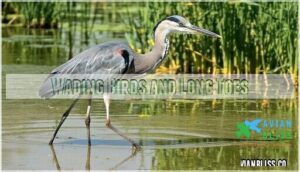This site is supported by our readers. We may earn a commission, at no cost to you, if you purchase through links.

Birds have evolved specialized beaks that function as precision instruments – think of a woodpecker’s chisel or a hummingbird’s straw.
Their feet tell stories too, with webbed toes for swimming, sharp talons for hunting, and extra-long digits for wading.
Feathers aren’t just for flying; they’re multipurpose gear that provides camouflage, insulation, and waterproofing.
These adaptations let birds thrive everywhere from scorching deserts to icy tundra.
Each species has fine-tuned its body parts over millions of years, creating some surprisingly clever solutions to life’s challenges, allowing them to live in various environments with specialized beaks.
Table Of Contents
- Key Takeaways
- Bird Adaptations for Survival
- What Are Bird Adaptations?
- Types of Bird Beaks
- Bird Feet and Leg Adaptations
- Importance of Plumage in Bird Survival
- Birds Adapted for Flight
- Bird Adaptations for Conservation
- Adaptations for Survival in Different Habitats
- Unique Adaptations in Different Bird Species
- Role of Adaptation in Bird Evolution
- Frequently Asked Questions (FAQs)
- What adaptations do birds have to survive?
- What are 4 adaptations of a bird?
- What are the 7 adaptations that allow birds to fly?
- What are 5 examples of structural adaptations?
- What is adaptation in birds?
- How do birds adapt to their environment?
- What are some examples of bird adaptations?
- How are birds adapted for flight?
- Are birds adapted to their beaks?
- How do birds survive?
- Conclusion
Key Takeaways
- You’ll discover that bird beaks function like specialized tools – conical beaks crack tough seeds, hooked beaks tear meat efficiently, and straight beaks handle diverse omnivorous diets, with each shape perfectly matched to specific feeding needs through millions of years of evolution.
- You’ll find that bird feet tell survival stories – webbed toes work like built-in flippers for swimming, sharp talons generate crushing force for hunting (up to 500 pounds in harpy eagles), and long toes distribute weight like natural snowshoes for wading birds.
- You’ll see that feathers serve as multipurpose survival gear – they provide camouflage through cryptic coloration, insulation against temperature extremes, waterproofing for aquatic birds, and specialized flight adaptations like the owl’s silent feathers that muffle sound during hunting.
- You’ll understand that these adaptations enable birds to thrive in extreme environments – from desert birds using large beaks as natural air conditioners to arctic species with dense plumage insulation, each feature represents nature’s ingenious solution to specific survival challenges across diverse habitats.
Bird Adaptations for Survival
You’ll discover how birds’ specialized beaks, feet, and feathers work together like a perfectly designed toolkit, with each feature shaped by millions of years of evolution to help them find food, escape predators, and thrive in their specific environments.
These remarkable adaptations, from the cardinal’s seed-cracking beak to the owl’s silent flight feathers, reveal nature’s ingenious solutions to survival challenges that’d make any engineer jealous.
Nature’s feathered engineers showcase millions of years of evolutionary brilliance in every perfectly crafted survival tool.
Beak Shapes and Sizes
Bird beaks showcase nature’s evolutionary masterpiece, with each shape perfectly matched to specific dietary niches.
You’ll find incredible beak morphology diversity that maximizes feeding efficiency under different evolutionary pressures.
Specialized beaks reveal nature’s ingenuity:
- Conical beaks crack tough seeds with powerful pressure
- Hooked beaks tear meat efficiently for predatory species
- Straight beaks handle varied omnivorous diets flexibly
- Specialized beaks perform unique functions like filter-feeding
For instance, conical beak designs are prevalent.
Foot Structures and Nails
Looking beyond beaks, you’ll discover that avian foot structure reveals nature’s engineering genius.
Each species sports specialized feet perfectly matched to their lifestyle needs.
Wading birds feature elongated toes that distribute weight across muddy surfaces like natural snowshoes.
Waterfowl display webbed feet functioning as built-in flippers for efficient swimming.
Meanwhile, climbing foot adaptations include zygodactyl feet – two toes forward, two backward – giving woodpeckers superior tree-gripping power.
Raptors possess grasping talons with incredible strength; harpy eagles generate 500 pounds of crushing force.
Running adaptations in ground birds feature powerful legs for speed, while foot insulation helps species survive harsh climates through specialized scales and feather coverage.
Plumage and Camouflage
Mastering survival through plumage coloration transforms ordinary birds into nature’s escape artists.
Your feathered neighbors showcase cryptically colored patterns that blend seamlessly with bark, leaves, and shadows.
Camouflage plumage serves multiple feather functions beyond hiding—it’s nature’s Swiss Army knife.
Here are 4 incredible ways birds use their colorful coats:
- Seasonal molting refreshes camouflage effectiveness for changing environments
- Feather patterns create optical illusions that confuse predators
- Avian mimicry tricks foes into mistaking birds for dangerous creatures
- Specialized plumage enables silent, stealthy movement through dense vegetation
What Are Bird Adaptations?
Imagine witnessing nature’s most ingenious solutions unfold before your eyes.
Bird adaptations represent millions of years of evolutionary fine-tuning, creating physiological traits perfectly matched to survival needs.
These sensory adaptations and behavioral adaptations showcase adaptive significance in every detail.
You’ll discover how avian survival depends on specialized features like beak types for feeding, feather functions for insulation, and bird flight mechanics.
Each adaptation reflects habitat specificity, transforming ordinary creatures into aerial masters through nature’s relentless innovation.
Types of Bird Beaks
You’ve probably noticed that birds don’t all have the same beak shape, and there’s a fascinating reason for this variety.
Each beak type has evolved over millions of years to match a bird’s specific diet and feeding habits, creating perfect tools for survival in different environments.
Conical Beaks for Seed-Eating
Mother Nature equipped seed-eating birds with the perfect nutcracker – their conical beaks.
You’ll find these sturdy, cone-shaped bills on finches, cardinals, and sparrows, where beak morphology directly reflects their specialized diets.
The seed cracking force these birds generate is remarkable, allowing them to crack sunflower seeds that would challenge your fingernails.
This evolutionary advantage stems from millions of years of natural selection, where habitat influence shaped these bird adaptations.
Different beak types evolved to match specific food sources, creating perfect diet specificity.
Seedeating birds showcase nature’s engineering through their powerful bills:
- Crushing tough seed shells with precision
- Extracting nutritious kernels efficiently
- Processing various seed sizes and hardness levels
- Accessing diverse plant foods year-round
- Maximizing energy intake from available resources
Hooked Beaks for Meat-Eating
Predatory birds typically develop hooked beaks that work like nature’s can openers.
These curved tools excel at tearing meat, giving raptors distinct evolutionary advantages in hunting techniques.
You’ll notice how beak morphology directly supports their carnivorous diets – hawks slice through small mammals, while eagles tackle larger prey with ease.
This prey specialization means each species has evolved the perfect hook for their preferred meals.
The sharp curve pierces, plucks, and pulls flesh into manageable pieces, making these beaks incredibly efficient hunting instruments.
Straight Beaks for Omnivorous Birds
You’ll notice that omnivorous birds possess remarkably versatile straight beaks that function like nature’s Swiss Army knife.
These medium-length bills showcase perfect beak morphology for diverse feeding behavior, allowing birds to switch between seeds, insects, berries, and small prey with ease.
Dietary versatility provides significant evolutionary advantage in changing environments.
- Crows and ravens use their adaptable beaks to crack nuts, catch insects, and scavenge meat
- Jays and magpies exploit seasonal food sources, from acorns to bird eggs
- Habitat influence shapes these beak specialization patterns across different ecosystems
Bird Feet and Leg Adaptations
You’ve probably never thought about how a duck’s webbed feet work like built-in flippers, or why herons can stand so gracefully in shallow water without sinking.
Bird feet and legs have evolved into specialized tools that match each species’ lifestyle, from the eagle’s powerful talons that can exert 500 pounds of pressure to the coot’s unique lobate toes that work perfectly for both swimming and walking on muddy surfaces, showcasing the remarkable adaptability of bird feet.
Wading Birds and Long Toes
The remarkable long toes of wading birds like egrets and herons serve as nature’s snowshoes, distributing weight across soft wetland surfaces.
This foot structure enhances Habitat Stability while reducing Predation Risks through silent movement.
Evolutionary Pressures shaped these bird adaptations to maximize Foraging Success in shallow waters, making Conservation Efforts essential for protecting these specialized hunters.
Many resources detail avian pedal morphology.
| Adaptation Feature | Function | Survival Benefit |
|---|---|---|
| Extended toe length | Weight distribution | Prevents sinking in mud |
| Flexible joints | Silent movement | Reduces prey detection |
| Specialized grip | Secure footing | Maintains hunting position |
Webbed Feet for Swimming
Webbed feet transform waterfowl into aquatic athletes, with flexible membranes connecting their toes for superior swimming efficiency.
You’ll find this remarkable foot structure creates natural paddles that propel birds through water effortlessly.
Here’s how webbed feet enhance aquatic locomotion:
- Webbing types vary from full webs to partial connections
- Foot propulsion increases with wider toe spacing
- Swimming efficiency improves through paddle-like motion
- Waterfowl adaptations include waterproof leg scales
- Bird foot adaptations enable both surface gliding and underwater diving
For specialized needs, consider purchasing webbed waders for enhanced aquatic activities.
Lobate Feet for Swimming and Wading
Lobate feet represent nature’s ingenious compromise between swimming power and walking versatility.
You’ll find these specialized foot structures on birds like the American Coot, grebes, and phalaropes.
Unlike fully webbed feet, lobate feet feature hinged flaps that expand for underwater propulsion, then fold back for efficient land movement.
This Alternative Adaptation showcases remarkable Lobate Foot Biomechanics – the lobes increase surface area during Coot Locomotion through water while maintaining mobility across mud, grass, and ice.
These Evolutionary Advantages demonstrate perfect Habitat Specificity for wading birds traversing diverse wetland environments.
Importance of Plumage in Bird Survival
You’ve probably noticed how some birds sport vibrant colors while others blend perfectly into their surroundings, but these feather patterns aren’t just for show.
A bird’s plumage serves three critical survival functions: attracting mates for reproduction, providing camouflage from predators and prey, and creating specialized flight adaptations that can mean the difference between life and death.
Attractive Plumage for Mating
You’ve probably noticed how male peacocks fan their brilliant tail feathers or cardinals flash their crimson plumage during spring.
This isn’t just showing off—it’s plumage signaling at work.
Bright feathers indicate genetic fitness and health, making males irresistible to females.
Sexual dimorphism evolved because flashy colors boost mate selection success, ensuring the strongest genes survive.
Camouflage for Hiding and Sneaking
You’ve witnessed nature’s ultimate hide-and-seek champions in action.
Birds master three essential camouflage techniques for predator evasion:
- Cryptic coloration blends them seamlessly into backgrounds
- Disruptive patterns break up their body outline
- Mimicry adaptations make them resemble twigs or leaves
These bird camouflage techniques represent millions of years of avian stealth evolution, turning ordinary feathers into survival masterpieces.
Specialized Flight Feathers
Beyond camouflage, you’ll discover how silent flight transforms owls into perfect nighttime hunters.
Their specialized feathers feature soft, fringed edges that eliminate wind noise during flight.
This remarkable flight adaptation allows for stealthy approaches to unsuspecting prey.
The unique feather aerodynamics work like built-in silencers, making owls nearly invisible to both sight and sound while hunting.
Birds Adapted for Flight
You’ll discover that birds possess remarkable adaptations that make them nature’s most efficient flying machines, from hollow bones that reduce weight to powerful chest muscles that generate incredible lift.
These specialized features, including streamlined body shapes and precisely designed wing structures, work together to create the perfect balance of strength and lightness needed for sustained flight, utilizing their hollow bones to reduce weight and powerful chest muscles to generate lift.
Lightweight Bones and Powerful Muscles
Through millions of years of evolution, you’ll find that birds possess remarkably lightweight bones with hollow interiors—a process called bone pneumatization—that maintains skeletal strength while reducing weight.
Their powerful muscles, especially flight muscles, contain specialized muscle fiber packed with mitochondria to meet intense metabolic demands.
These bird physical characteristics create incredible flight efficiency:
- Hollow bones reduce body weight by up to 20%
- Flight muscles comprise 15-25% of total body weight
- Bird flight adaptations enable sustained aerial performance
Wing Shapes and Sizes
Beyond lightweight bones and powerful muscles, wing shapes determine how you’ll see birds navigate their aerial world.
Different wing configurations serve distinct purposes in bird flight adaptations.
| Wing Type | Aspect Ratio | Flight Efficiency |
|---|---|---|
| Long/Narrow | High | Excellent soaring |
| Short/Broad | Low | Quick maneuvers |
| Pointed | Medium | Fast migration patterns |
Wing loading affects soaring vs flapping techniques.
Hawks use broad wings for thermals, while falcons employ pointed wings for speed.
Each wing formation reflects millions of years of evolutionary fine-tuning.
Flight Styles and Techniques
You’ll spot five distinct flight styles as you watch birds navigate the skies.
Soaring vs. flapping reveals energy strategies – eagles ride thermals while sparrows bound through air.
Hovering techniques let hummingbirds feed mid-flight, their specialized flight muscles beating wings 80 times per second.
Formation flying helps geese conserve energy during migratory flight, while quick turns provide predator evasion for smaller species.
Bird Adaptations for Conservation
You’ll discover how understanding bird adaptations becomes essential when scientists work to protect endangered species from habitat loss and climate change.
These evolutionary features that helped birds survive for millions of years now guide conservation efforts, as researchers use knowledge of specific beak shapes, foot structures, and flight patterns to create targeted protection strategies for threatened populations, utilizing their understanding of bird adaptations.
Threats Facing Native Bird Species
While birds have mastered flight through millions of years of evolution, they’re now facing unprecedented challenges that threaten their very existence.
Habitat Loss devastates bird populations as agriculture and development destroy nesting grounds. Climate Change disrupts migration patterns and breeding cycles.
Invasive Species introduce fierce competition and deadly diseases. Pollution Impact from pesticides weakens immune systems, while Human Activity creates deadly obstacles like glass buildings and wind turbines.
- Agriculture expansion threatens 1,026 bird species worldwide
- Invasive predators eat eggs and kill defenseless nestlings
- Global warming endangers two-thirds of North American species
- Toxic pesticides reduce insect populations that birds depend on
- Glass collisions kill millions of migrating birds annually
Strategies for Protecting Endangered Birds
Saving endangered birds demands targeted action that matches their evolutionary strengths.
Habitat Preservation creates safe zones where species can thrive, while Captive Breeding programs rebuild wild populations.
Strong Legislation Enforcement prevents illegal hunting, and Public Awareness campaigns inspire community involvement.
These bird conservation strategies combat Climate Change impacts effectively.
| Strategy | Implementation |
|---|---|
| Habitat Protection | Restore wetlands, forests, grasslands |
| Breeding Programs | Reintroduce species to wild habitats |
| Legal Enforcement | Monitor hunting, trade regulations |
| Education Outreach | Engage schools, communities in conservation |
Importance of Understanding Bird Adaptations
The importance of understanding bird adaptations extends far beyond academic curiosity—it’s your key to accessing effective conservation strategies.
When you grasp how evolutionary insights shape survival mechanisms, you’ll recognize each species’ unique environmental adaptation needs.
This knowledge reveals vital conservation benefits:
- Restore habitats matching specific avian adaptations requirements
- Reduce human impact on vulnerable bird survival strategies
- Monitor population changes using ecosystem roles understanding
- Prioritize research priorities for at-risk species protection
By applying these insights, you can make a significant difference in the lives of birds and contribute to a better understanding of their environmental adaptation needs.
Adaptations for Survival in Different Habitats
You’ll discover how birds have evolved remarkable features to thrive in vastly different environments, from scorching deserts where water is scarce to dense forests filled with competition for food.
These habitat-specific adaptations demonstrate nature’s incredible ability to shape every aspect of a bird’s anatomy, behavior, and survival strategies to match the unique challenges of their chosen homes, showcasing nature’s incredible ability.
Desert-Dwelling Birds
You’ll find desert-dwelling birds have mastered remarkable survival tricks in scorching environments.
Their large beaks act like natural air conditioners, releasing excess heat efficiently.
Dense plumage provides surprising insulation against temperature swings, while specialized kidneys minimize water loss.
These clever birds seek shade during blazing afternoons, becoming active at dawn when it’s cooler and safer.
Forest-Dwelling Birds
You’ll find that forest-dwelling birds showcase incredible habitat adaptation techniques.
Their camouflage helps them master predation avoidance while traversing dense woodlands.
Key forest-dwelling birds adaptations include:
- Canopy Navigation – Strong claws grip bark surfaces securely
- Understory Foraging – Sharp beaks extract insects from crevices
- Nesting Strategies – Hidden nests protect vulnerable offspring
- Forest Dependence – Specialized foraging techniques target specific food sources
- Stealth Movement – Silent flight patterns avoid detection
Grassland-Dwelling Birds
While forest birds master the art of vertical living, grassland-dwelling birds face different challenges in wide-open spaces.
You’ll notice their camouflage patterns mirror dried grasses and earth tones, making predator evasion easier.
Their habitat adaptation includes ground nesting strategies that hide eggs from hawks circling overhead.
Foraging techniques focus on grassland diet staples like seeds and insects, while their bird behavior supports vital seed dispersal across prairies.
Unique Adaptations in Different Bird Species
You’ll discover that different bird species have evolved remarkable adaptations that help them thrive in their specific environments, from the harpy eagle’s five-inch talons that exert crushing force to the flamingo’s comma-shaped beak that filters tiny organisms from muddy water.
These specialized features, including silent owl flight feathers and the Philippine Eagle’s 500-pound grip strength, demonstrate how natural selection has fine-tuned each species for survival success.
The variety of these adaptations, such as the harpy eagle’s five-inch talons, showcases the diversity of solutions birds have developed to survive and thrive in different ecosystems.
Specialized Beaks and Feet
You’ll discover that specialized beaks and feet represent nature’s most ingenious engineering solutions. These remarkable bird adaptations showcase perfect Dietary Correlation – each feature matches exactly what a bird needs to survive.
Evolutionary Pressures have sculpted these tools over millions of years, creating Functional Morphology that’s both beautiful and brutally efficient.
Habitat Influence shapes every curve and claw you see. Desert birds develop different foot structures than forest dwellers, while Niche Partitioning guarantees species don’t compete for the same resources.
Consider these amazing examples:
- Sword-billed hummingbirds sport beaks longer than their entire bodies for reaching deep flowers
- Raptors combine razor-sharp talons with curved beaks for efficient hunting
- Black skimmers use specialized lower beaks to slice through water while fishing
Each adaptation tells a survival story. When you observe birds closely, you’re witnessing millions of years of fine-tuning in action.
Unique Plumage and Camouflage
When birds master the art of disguise, their plumage becomes nature’s ultimate camouflage toolkit.
You’ll find cryptic coloration helping nightjars vanish against bark, while iridescent feathers create stunning mating displays.
These feather patterns serve dual purposes—thermal regulation and species mimicry.
From speckled browns to bold ultraviolet markings, bird plumage functions as both survival armor and communication device.
Adaptations for Flight and Migration
While plumage helps birds blend in, their flight adaptations truly showcase evolutionary brilliance.
You’ll witness how wing morphology varies dramatically – from albatross wingspans exceeding 11 feet for effortless soaring to hummingbird wings beating 80 times per second.
Bird flight mechanics involve hollow bones, powerful muscles, and specialized feathers that enable incredible migration patterns, navigation skills, and altitude adaptations spanning continents.
Role of Adaptation in Bird Evolution
You’re witnessing the result of 150 million years of evolutionary fine-tuning, where each beak shape, foot structure, and feather pattern tells a story of survival against incredible odds.
When you understand how birds evolved from their dinosaur ancestors, you’ll see that every adaptation—from the cardinal’s seed-cracking beak to the owl’s silent flight feathers—represents nature’s solution to life-or-death challenges, including the development of specific traits like the cardinal’s seed-cracking beak.
Evolutionary History of Birds
Millions of years ago, you’d witness the remarkable transformation from fierce theropod dinosaurs to today’s graceful birds.
The Archaeopteryx lithographica fossil reveals this incredible journey, showing how feather evolution began long before flight development. You can trace avian origins through these ancient specimens, where primitive plumage first provided insulation rather than flight capabilities.
Theropod ancestry connects modern birds directly to their dinosaur relatives, with evolutionary adaptations shaping every aspect of avian biology. Flight development took countless generations to perfect, transforming simple gliding into powered aerial mastery.
Understanding bird evolution history helps you appreciate how natural selection crafted today’s diverse species, from tiny hummingbirds to soaring eagles.
Adaptations for Survival in Changing Environments
When faced with climate change and habitat loss, you’ll witness birds demonstrating remarkable behavioral plasticity.
These evolutionary adaptations include migration shifts to track favorable conditions and diet adjustments when food sources disappear.
Their environmental adaptation strategies showcase nature’s resilience, helping species survive despite rapidly changing landscapes.
Understanding these survival mechanisms reveals bird adaptations that continue evolving today.
Importance of Studying Bird Adaptations
When you study bird adaptations, you’re gaining evolutionary insights that reveal how species survive environmental changes.
These discoveries have major conservation implications, helping scientists understand ecosystem health and human impact on wildlife.
Your knowledge of bird behavior and survival strategies guides future research, ensuring we can protect these remarkable creatures as our planet continues changing.
Frequently Asked Questions (FAQs)
What adaptations do birds have to survive?
Birds have evolved remarkable survival features: specialized beaks for different diets, webbed or taloned feet for their habitats, camouflaged plumage for protection, hollow bones for flight, and efficient respiratory systems supporting high-energy activities.
What are 4 adaptations of a bird?
Picture a cardinal cracking sunflower seeds with ease.
You’ll notice four key adaptations: specialized beaks shaped for specific diets, strong feet for perching and grasping, colorful plumage for mating displays, and hollow bones enabling efficient flight.
What are the 7 adaptations that allow birds to fly?
You’ll notice seven key flight adaptations: hollow bones reduce weight, powerful flight muscles provide lift, streamlined body shape cuts air resistance, specialized feathers enable control, efficient respiratory system fuels flight, keen eyesight aids navigation, and lightweight skull maintains balance.
What are 5 examples of structural adaptations?
Like nature’s Swiss Army knife, you’ll find birds showcase five key structural adaptations: hollow bones for lightweight flight.
Specialized beaks matching their diet.
Webbed or taloned feet for habitat needs.
Streamlined bodies reducing air resistance.
And insulating feathers.
What is adaptation in birds?
You’ll find adaptation in birds refers to evolutionary changes that help them survive and thrive.
These modifications include specialized beaks for different diets, feet for various habitats, and feathers for flight, insulation, and camouflage.
How do birds adapt to their environment?
Nature’s master sculptors, birds shape-shift through evolution’s chisel.
You’ll witness beaks morphing for specific diets, feet transforming for terrain navigation, and feathers adapting for flight, camouflage, or mate attraction—each change ensuring survival success.
What are some examples of bird adaptations?
You’ll spot amazing adaptations everywhere: cardinals crack seeds with thick beaks, eagles tear meat with hooked bills.
Ducks swim using webbed feet, and owls hunt silently with specialized feathers that muffle sound.
How are birds adapted for flight?
You’d think something so graceful would struggle to get airborne, yet birds master flight through hollow bones that reduce weight, streamlined bodies cutting air resistance.
They achieve this mastery through powerful flight muscles driving specialized feathers.
Are birds adapted to their beaks?
Birds aren’t adapted to their beaks – it’s the opposite.
You’ll find that beaks evolved to match specific diets and environments.
Sharp hooks tear meat, while cone shapes crack seeds perfectly for survival.
How do birds survive?
You’ll find that birds master survival through specialized adaptations.
Sharp beaks crack seeds or tear meat, webbed feet aid swimming, and camouflaged feathers hide them from predators while attracting mates.
Conclusion
Consider how a tiny arctic tern travels 44,000 miles annually from Arctic to Antarctic, relying on streamlined wings and precise navigation instincts.
This remarkable journey showcases how bird adaptations for survival have evolved over millions of years.
You’ve discovered how specialized beaks, feet, and feathers help birds thrive in diverse environments.
Understanding these adaptations isn’t just fascinating—it’s essential for conservation efforts.
Each species represents nature’s problem-solving genius, perfectly equipped for their unique challenges and habitats.
















